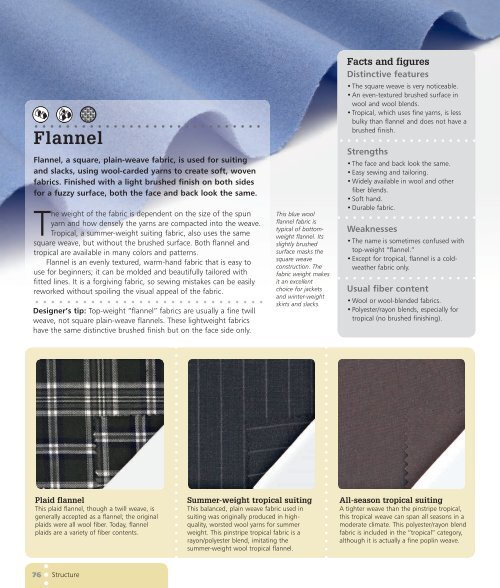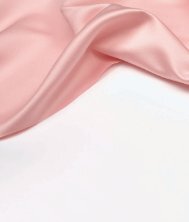You also want an ePaper? Increase the reach of your titles
YUMPU automatically turns print PDFs into web optimized ePapers that Google loves.
Flannel<br />
Flannel, a square, plain-weave fabric, is used for suiting<br />
and slacks, using wool-carded yarns to create soft, woven<br />
fabrics. Finished with a light brushed finish on both sides<br />
for a fuzzy surface, both the face and back look the same.<br />
The weight of the fabric is dependent on the size of the spun<br />
yarn and how densely the yarns are compacted into the weave.<br />
Tropical, a summer-weight suiting fabric, also uses the same<br />
square weave, but without the brushed surface. Both flannel and<br />
tropical are available in many colors and patterns.<br />
Flannel is an evenly textured, warm-hand fabric that is easy to<br />
use for beginners; it can be molded and beautifully tailored with<br />
fitted lines. It is a forgiving fabric, so sewing mistakes can be easily<br />
reworked without spoiling the visual appeal of the fabric.<br />
Designer’s tip: Top-weight “flannel” fabrics are usually a fine twill<br />
weave, not square plain-weave flannels. These lightweight fabrics<br />
have the same distinctive brushed finish but on the face side only.<br />
This blue wool<br />
flannel fabric is<br />
typical of bottomweight<br />
flannel. Its<br />
slightly brushed<br />
surface masks the<br />
square weave<br />
construction. The<br />
fabric weight makes<br />
it an excellent<br />
choice for jackets<br />
and winter-weight<br />
skirts and slacks.<br />
Facts and figures<br />
Distinctive features<br />
• The square weave is very noticeable.<br />
• An even-textured brushed surface in<br />
wool and wool blends.<br />
• Tropical, which uses fine yarns, is less<br />
bulky than flannel and does not have a<br />
brushed finish.<br />
Strengths<br />
• The face and back look the same.<br />
• Easy sewing and tailoring.<br />
• Widely available in wool and other<br />
fiber blends.<br />
• Soft hand.<br />
• Durable fabric.<br />
Weaknesses<br />
• The name is sometimes confused with<br />
top-weight “flannel.”<br />
• Except for tropical, flannel is a coldweather<br />
fabric only.<br />
Usual fiber content<br />
• Wool or wool-blended fabrics.<br />
• Polyester/rayon blends, especially for<br />
tropical (no brushed finishing).<br />
Plaid flannel<br />
This plaid flannel, though a twill weave, is<br />
generally accepted as a flannel; the original<br />
plaids were all wool fiber. Today, flannel<br />
plaids are a variety of fiber contents.<br />
Summer-weight tropical suiting<br />
This balanced, plain weave fabric used in<br />
suiting was originally produced in highquality,<br />
worsted wool yarns for summer<br />
weight. This pinstripe tropical fabric is a<br />
rayon/polyester blend, imitating the<br />
summer-weight wool tropical flannel.<br />
All-season tropical suiting<br />
A tighter weave than the pinstripe tropical,<br />
this tropical weave can span all seasons in a<br />
moderate climate. This polyester/rayon blend<br />
fabric is included in the “tropical” category,<br />
although it is actually a fine poplin weave.<br />
•••<br />
76 Structure



